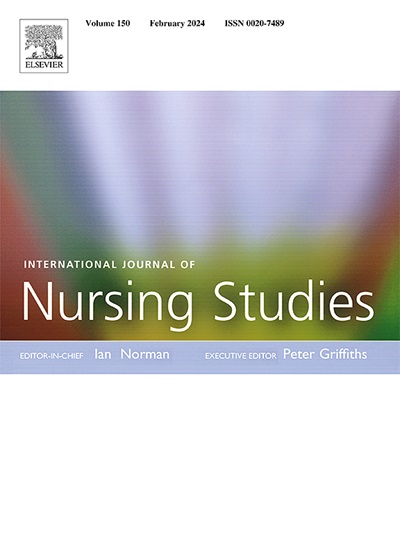A nurse-led bedside diagnostic model using cervical tracheal breath sounds to detect silent aspiration in dysphagia patients: A prospective diagnostic accuracy study
IF 7.1
1区 医学
Q1 NURSING
引用次数: 0
Abstract
Background
Silent aspiration poses significant clinical risks in dysphagia patients, contributing to recurrent respiratory infections and aspiration pneumonia that ultimately result in elevated hospitalization rates and increased mortality. While video fluoroscopic swallowing studies (VFSS) and fiberoptic endoscopic evaluation of swallowing (FEES) remain the diagnostic gold standards, their high costs create substantial barriers to efficient large-scale screening. Conventional bedside swallowing assessments demonstrate limited sensitivity for silent aspiration detection due to inherent subjectivity in evaluation process. This diagnostic dilemma presents nursing professionals with critical challenges in achieving timely and accurate identification of aspiration events.
Objective
To develop and validate a diagnostic model for detecting silent aspiration in dysphagia patients through acoustic analysis of breath sound parameters.
Design
A prospective diagnostic accuracy study.
Settings
Four hospitals in Nanjing, China.
Participants
A total of 212 patients with dysphagia were included in this study.
Methods
Breath sounds were recorded with an electronic stethoscope, and acoustic parameters were extracted via Fourier transform spectral analysis. The relative change in acoustic parameters was quantified by comparing post-swallow measurements against baseline values. Based on VFSS/FEES findings, breath sounds were categorized into no aspiration, silent aspiration, and overt aspiration. Through computer-generated randomization, samples were stratified into modeling (70 %) and validation (30 %) groups. A logistic regression diagnostic model was developed in the modeling cohort, with subsequent evaluation of its performance in the validation group using receiver operating characteristic (ROC) curve analysis.
Results
Silent aspiration breath sounds demonstrated comparable prevalence between cohorts, occurring in 41.6 % (226/543; modeling group) and 41.8 % (97/232; validation group). The derived logistic model comprised three acoustic parameters with the following equation: logit(P) = − 0.621 − (0.672 × change of aggregated entropy) + (0.279 × change of average power) + (0.632 × change of delta time). ROC analysis revealed comparable diagnostic performance between cohorts, with the modeling cohort demonstrating an AUC of 0.785 (95 % CI: 0.744–0.821) and the validation cohort achieving 0.746 (95 % CI: 0.679–0.806).
Conclusion
A novel acoustic-based diagnostic model for silent aspiration risk stratification in dysphagia patients demonstrated good discriminatory power across both modeling and validated cohorts. This decision-support tool enables nursing staff to proactively identify high-risk patients through continuous monitoring, facilitating early implementation of aspiration-prevention protocols.
一种由护士主导的床边诊断模型,使用颈部气管呼吸音检测吞咽困难患者的无音误吸:一项前瞻性诊断准确性研究
背景无声误吸对吞咽困难患者具有显著的临床风险,可导致反复呼吸道感染和吸入性肺炎,最终导致住院率升高和死亡率增加。虽然视频透视吞咽研究(VFSS)和光纤内镜吞咽评估(FEES)仍然是诊断的金标准,但它们的高成本对有效的大规模筛查造成了实质性障碍。由于评估过程中固有的主观性,传统的床边吞咽评估对无声误吸检测的敏感性有限。这种诊断困境提出了护理专业人员在实现及时和准确的识别误吸事件的关键挑战。目的通过呼吸声参数的声学分析,建立并验证吞咽困难患者无音误吸诊断模型。设计一项前瞻性诊断准确性研究。背景:中国南京有四家医院。共有212例吞咽困难患者纳入本研究。方法用电子听诊器记录呼吸音,通过傅里叶变换谱分析提取呼吸声参数。通过比较吞咽后的测量值与基线值来量化声学参数的相对变化。根据VFSS/FEES检查结果,呼吸音分为无吸气、无声吸气和明显吸气。通过计算机随机化,将样本分为建模组(70%)和验证组(30%)。在建模队列中建立逻辑回归诊断模型,随后使用受试者工作特征(ROC)曲线分析评估其在验证组中的表现。结果无声吸气呼吸音在队列间的患病率相当,发生率为41.6% (226/543;造模组)和41.8% (97/232;验证组)。导出的logistic模型由三个声学参数组成,其方程为:logit(P) =−0.621−(0.672 ×聚合熵变化)+ (0.279 ×平均功率变化)+ (0.632 × δ时间变化)。ROC分析显示各队列之间的诊断性能具有可比性,建模队列的AUC为0.785 (95% CI: 0.744-0.821),验证队列的AUC为0.746 (95% CI: 0.679-0.806)。结论一种新的基于声学的吞咽困难患者无声误吸风险分层诊断模型在建模和验证队列中都具有良好的区分能力。这一决策支持工具使护理人员能够通过持续监测主动识别高危患者,促进早期实施预防吸入方案。
本文章由计算机程序翻译,如有差异,请以英文原文为准。
求助全文
约1分钟内获得全文
求助全文
来源期刊
CiteScore
15.00
自引率
2.50%
发文量
181
审稿时长
21 days
期刊介绍:
The International Journal of Nursing Studies (IJNS) is a highly respected journal that has been publishing original peer-reviewed articles since 1963. It provides a forum for original research and scholarship about health care delivery, organisation, management, workforce, policy, and research methods relevant to nursing, midwifery, and other health related professions. The journal aims to support evidence informed policy and practice by publishing research, systematic and other scholarly reviews, critical discussion, and commentary of the highest standard. The IJNS is indexed in major databases including PubMed, Medline, Thomson Reuters - Science Citation Index, Scopus, Thomson Reuters - Social Science Citation Index, CINAHL, and the BNI (British Nursing Index).

 求助内容:
求助内容: 应助结果提醒方式:
应助结果提醒方式:


